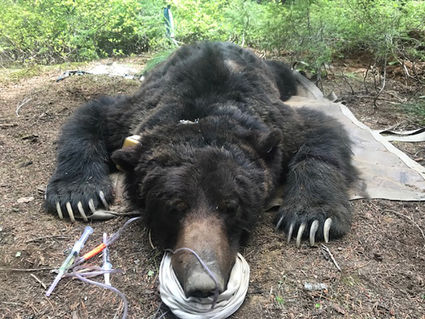Biologist presents update on area grizzly bears
November 22, 2018

Courtesy Photo
MALE GRIZZLY captured in the Washington Selkirk Mountains in 2018. FWP has recently released the full Cabinet-Yaak and Selkirk Mountains Grizzly Bear Monitoring Update to the public.
Wayne Kasworm, U.S. Fish and Wildlife Service biologist out of Libby, has recently released the Cabinet-Yaak and Selkirk Mountains Grizzly Bear Monitoring Update. The report includes information gathered and analyzed for the 2018 monitoring season.
In the Selkirk Mountains region, eight grizzly bears were identified. Of these, four were male and four were female. Two of these eight were previously captured and collared. One moved west of Pend Oreille River in early October and then returned to the area. A two-year old male was trapped near Rathdrum, Idaho and transferred to the Cabinet Mountains in Montana, but has recently been identified in the northern Bonners Ferry Selkirk range.
Another two-year old male was captured and collared in the Selkirk Mountains. He has travelled over 125 miles and was discovered in the Cabinet-Yaak region. Recently, he was observed in the Fisher River drainage and has lost his collar.
Of the female Selkirk bears, one collared grizzly has been determined to have yearling cubs while two other females are determined to not have reproduced, according to the report.
A total of 11 grizzlies have been documented in the Cabinet Mountain region. A young male was captured east of the McGregor Lake recovery area. He was relocated to the west side of Koocanusa Reservoir at the Big Creek drainage. In late September, another adult male, that has been collared multiple times since 2011, was trapped in the Yaak River region.
Of all the Yaak grizzlies, four are female and two of these four have two cubs each. The other two females are three to five years in age and have not reproduced. Radio collars were applied to two young females as part of FWP research monitoring and one male was transferred to the Cabinets as part of an augmentation project.
On July 21, 2018 this two-year-old augmentation-project male was released near Spar Lake in the west Cabinet Mountains. After traveling south, he crossed the Clark Fork River on August 7, downstream from Cabinet Gorge dam. On September 3 an Idaho resident reported seeing this male at a black bear baiting station. According to FWP, Montana prohibits baiting of bears and Idaho Fish and Game prohibits the activity north of the Clark Fork River and during black bear hunting season.
September 5 the same bear was trapped, collared and released in the South Fork of the Bull River area and has recently been located southwest of Heron, after being tracked on September 13 at the Clark Fork River location he previously visited on August 7.
Since 2007, three grizzly bears have been killed at black bear bait stations south of the Selkirk and Cabinet Mountain regions. One bear, who originated in the Selkirk region was killed in the Bitterroot recovery area.
Residential properties between Kalispell and Libby, in the McGregor Lake area, have been frequented by a young male grizzly that was captured and collared last May. After being released 25 miles north of Libby in the Big Creek drainage, the bear voyaged to the Cabinet Mountains and back to the Big Creek release area. The radio collar signaled signs of mortality to FWP personnel and it has been established the cause of death is human influence. The case is currently under investigation, FWP reports.
Another young male grizzly was being fed by several residents in the Rathdrum area the monitoring report claims. Idaho Fish and Game implemented a capture of the bear on August 15 and released him in the East Fork of Boulder Creek in the West Cabinet Mountains. The latest tracking has shown him to be habituating in the Kootenai River Valley north of Bonners Ferry.
As far as human mortality in the U.S. portion of the Selkirk Mountains, there are no known cases. In the Cabinet-Yaak region, there are two known and one probable instances of human-caused mortality. One case was previously described in the McGregor Lake region, and the other case is of an adult female found dead of human causes in the Canuck Creek area. This incident is under investigation by Idaho Fish and Game.
The bear of probable cause was recorded by a private trail camera in the Yaak as being injured or wounded in early spring. Kim Annis, Montana FWP Bear Specialist, collected hair samples of the bear for genetic analysis, as a carcass could not be located, for further assessment.
Genetic sampling from 2017 hair sample specimens have not been completed by the lab, but are expected soon, according to the report. Hair samples were collected at both recovery sites by visiting tree rubs monthly. Corrals and cameras are generally set up two to four weeks prior to collection to determine presence of young bears and to identify any special markings on the bears. All hair samples collected in 2018 have been catalogued and will be transported to the lab later this year or early 2019.
In the Poorman Creek drainage, 15 miles south of Libby, a woman was attacked by a grizzly bear on May 17, 2018. She was hiking in the Cabinet Mountains on a closed road collecting hair samples for the University of Montana though supervised by U.S. Fish and Wildlife Service.
A surprised bear bit her on the back of the neck and head while she deployed her bear spray, which may have saved her from suffering further injuries, the report reads. She contacted 911 immediately via satellite communications and was able to walk to her vehicle. She met with medical personnel who transported her to Kalispell Regional Hospital.
Amber Kornak spent several hours in surgery and has returned to limited-duty work on this project, according to FWP. Hair samples from the attack bear revealed the bear to be a male grizzly previously captured in the Cabinet Mountains in 2005. FWP determined the bear acted in a surprised, defensive manner and no further action was taken against the bear.
The research efforts of this monitoring project include cooperation and funding from Birchdale Ecological (M. Proctor), British Columbia Conservation Officer Service, Colville National Forest, Idaho Department of Lands, Idaho Fish and Game, Idaho Panhandle National Forest, Kalispel Tribe, Kootenai Tribe of Idaho, Montana Fish, Wildlife and Parks, Kootenai National Forest and Washington Department of Fish and Wildlife.
The project is led by the U.S. Fish and Wildlife Service through the Grizzly Bear Recovery Office. Funding from the Idaho and Washington state offices of the U.S. Fish and Wildlife Service has also contributed to the study. Private land owners who granted property access for the research include Caribou Mountain Lodge, Hancock Forest Management, Molpus Woodlands, Stimson Lumber and Weyerhaeuser Timber.
More information on the Cabinet-Yaak and Selkirk Mountains Grizzly Bear Monitoring Update can be found at http://www.fws.gov.






Reader Comments(0)